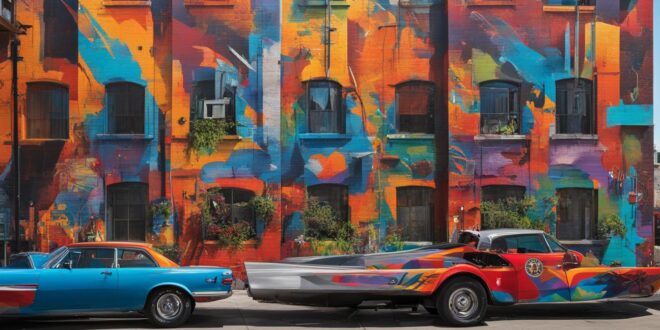Street art has emerged as a powerful and dynamic form of artistic expression across the globe. From urban murals to graffiti art, street art has become an integral part of the cultural fabric in many cities. This article aims to explore the diverse and vibrant world of street art, showcasing its evolution, impact, and the renowned street art scenes from around the world.
Key Takeaways:
- Street art is a global artistic movement that encompasses various forms of urban murals and graffiti art culture.
- Cities like New York City and Brooklyn are famous for their thriving street art scenes and renowned artists.
- Street art has the power to transform public spaces and add vibrancy and cultural identity to urban landscapes.
- Artists use street art as a medium for social commentary, political activism, and artistic expression.
- The digital age and online platforms have amplified the reach and impact of street art worldwide.
Understanding Street Art as an Artistic Movement
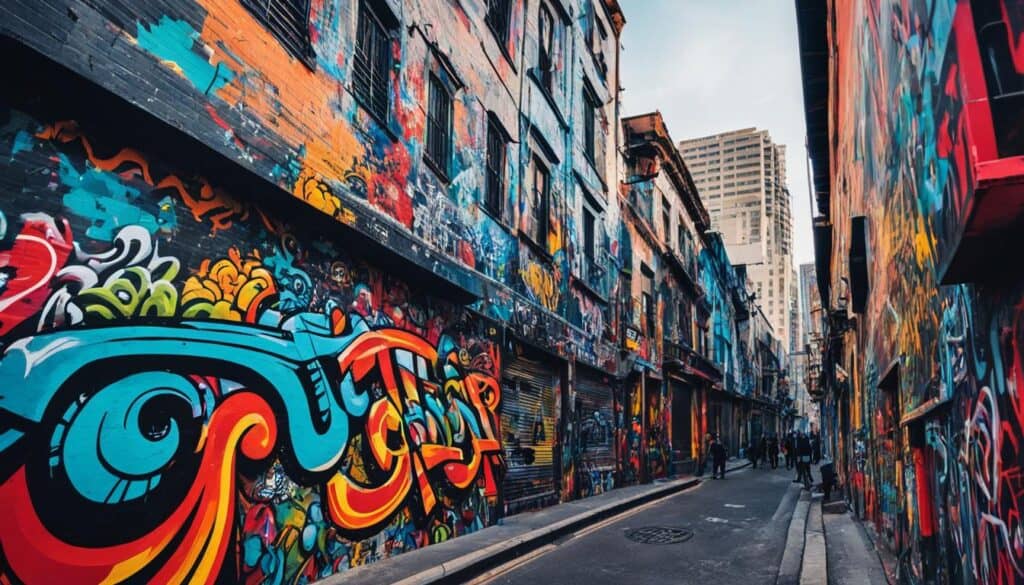
Street art, often associated with graffiti, is more than just vandalism. It is a legitimate form of artistic expression that challenges the traditional notions of art. Street art has its roots in the hip-hop culture of the 80s and has evolved into a global art movement.
Street art explores the relationship between art and the urban environment, often rejecting the commercial gallery system. It thrives outside the confines of traditional art spaces, finding its canvas on the walls of city streets and buildings. Street artists employ various techniques, from intricate murals to bold tags and stencils, to convey their messages.
This art movement transcends cultural barriers and thrives in urban environments worldwide. It acts as a statement against the conventional art world, ensuring accessibility to all, regardless of socio-economic background. Street art creates an immersive experience for viewers, provoking thought and sparking conversations about societal issues.
Street art captures the essence of the city, transforming its walls into open-air galleries that tell stories, challenge perceptions, and ignite imagination.
Culture jamming and subvertising are prevalent in street art, as artists use their creations to question dominant narratives and challenge consumerism. By appropriating advertisements and altering them with subversive messages, street artists disrupt the visual landscape of the urban environment. This unconventional form of artistic expression aims to reclaim public spaces and foster critical thinking among viewers.
The Impact on Commercial Galleries
Street art presents a notable alternative to the traditional art market and commercial gallery system. It often blurs the boundaries between art and activism, with artists operating outside the constraints of mainstream institutions. While some street artists have successfully transitioned into the gallery scene, many continue to embrace the unique and raw nature of street art.
The influence of street art extends beyond the physical artworks themselves. It has inspired a new generation of artists, sparking the growth of urban art festivals, workshops, and exhibitions. Street art’s ability to engage with communities directly has fostered a sense of shared ownership and empowerment.
Expanding the Boundaries of Art
Street art challenges the notion that art should be confined within gallery walls. It highlights the importance of artistic expression in public spaces, bringing art directly to the people. By embracing the ever-changing urban landscape as their canvas, street artists continue to push the boundaries of what art can be.
As an artistic movement, street art provokes conversations, sparks inspiration, and contributes to the vibrant cultural fabric of cities worldwide. The fusion of creativity, activism, and the urban environment makes street art a powerful force for change and self-expression.
The Influence of Street Art on Urban Landscapes

Street art has a profound impact on the urban landscapes and cityscapes where it is created. Through vibrant murals and graffiti, street art transforms public spaces into artistic canvases. It adds color, vibrancy, and a sense of identity to neighborhoods, creating a unique visual language that reflects the cultural values and social issues of a community.
Street art has the power to turn dull and monotonous city walls into captivating and thought-provoking displays of creativity. It injects life and energy into urban environments, making them more visually appealing and engaging for both residents and visitors.
One of the remarkable aspects of street art is its ability to capture the essence of a place and convey its cultural significance. Artists often draw inspiration from the local community, incorporating symbols, imagery, and themes that hold meaning for the people who live there. The result is a powerful fusion of artistic expression and cultural identity, where the walls of a city become a canvas for collective storytelling.
Street art also serves as a form of social commentary, raising awareness about important issues and sparking conversations. Artists use their work to shed light on social inequalities, environmental concerns, and political activism. By addressing these topics in public spaces, street art has the potential to engage and mobilize communities, amplifying their voices and advocating for change.
“Street art brings art to people where they are, in the heart of their daily lives. It breaks the boundaries of traditional art spaces and allows for a more inclusive and accessible artistic experience.” – [Artist Name]
The impact of street art goes beyond aesthetics. It stimulates local economies by attracting tourists and creating opportunities for cultural tourism. Cities that embrace street art as part of their cultural landscape often see an increase in visitor numbers, as people come to explore the vibrant art scenes and discover the hidden gems within their walls.
When street art thrives in public spaces, it enhances the overall quality of life in urban communities. It fosters a sense of pride and ownership among residents, who feel a connection to the artwork that brightens their surroundings. Additionally, street art inspires creativity and artistic expression, nurturing the growth of local talent and providing a platform for aspiring artists to showcase their work.
The influence of street art on urban landscapes cannot be overstated. It transforms ordinary spaces into extraordinary ones, capturing the spirit of a place and reflecting the cultural fabric of a community. Whether it’s a sprawling mural or a hidden graffiti message, street art shapes our cities, adding depth, meaning, and a touch of artistic magic to public spaces.
Renowned Street Art Hubs
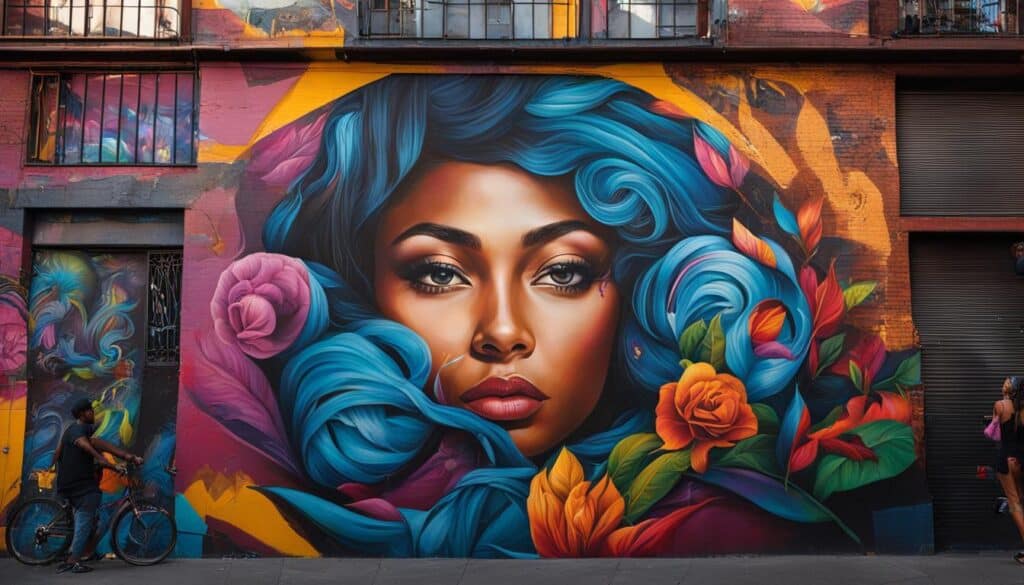
Certain cities around the world have emerged as renowned street art hubs, attracting artists and enthusiasts from all over. One such city is New York City, known for its vibrant street art scene that has captivated visitors and locals alike. In particular, the borough of Brooklyn has become synonymous with street art, boasting a rich and diverse collection of urban murals.
Walk through the streets of Brooklyn, and you’ll be greeted by a kaleidoscope of colors and captivating artworks on every corner. From large-scale murals adorning the sides of buildings to intricate stencil art tucked away in alleyways, the visual landscape of street art in Brooklyn is both awe-inspiring and immersive.
Internationally acclaimed street artists, such as Shepard Fairey, Banksy, and JR, have left their mark on the walls of Brooklyn, contributing to its ever-evolving urban mural scene. Local artists also play a vital role in shaping the street art culture, infusing their creativity and unique perspectives into the vibrant tapestry of Brooklyn’s urban landscape.
The street art scene in New York City, particularly in Brooklyn, provides a platform for artists to express themselves freely, address social issues, and push the boundaries of artistic innovation. By transforming the walls of the city into a visual playground, street art in Brooklyn has become a powerful form of self-expression, cultural commentary, and community engagement.
Immerse yourself in the eclectic streets of Brooklyn, and you’ll find a living, breathing testament to the global street art movement. These open-air galleries not only showcase the talent and creativity of artists but also invite viewers to become active participants in the exploration of art and urban culture.
The Power of Street Art to Convey Messages
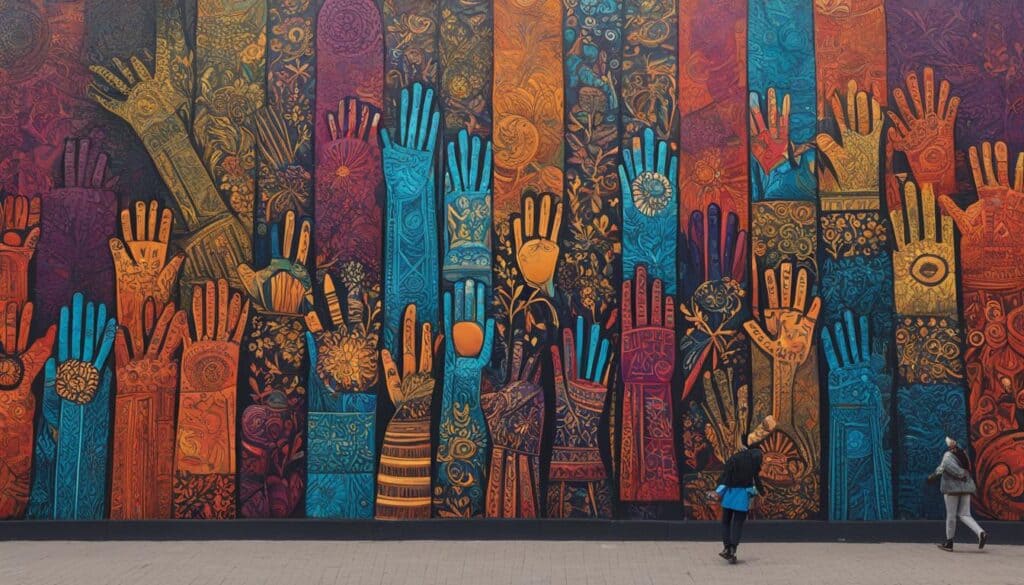
Street art goes beyond being a form of creative expression; it serves as a powerful medium for social commentary and political activism. Artists around the world utilize the streets as their canvas to raise awareness about pressing social issues, challenge oppressive systems, and give voice to marginalized communities. Through their art, they ignite conversations, provoke thought, and incite change, making street art a form of artistic activism with a wide-reaching impact.
Street artists tackle a range of social issues through their work, including inequality, racial injustice, gender discrimination, environmental concerns, and political corruption. They use powerful imagery, bold visuals, and thought-provoking messages to convey their sociopolitical views and spark meaningful conversations among viewers. By taking their art to public spaces, street artists ensure that their message reaches a diverse audience, transcending the boundaries of traditional art galleries.
Inspiring Social Change
Street art acts as a catalyst for social change, inspiring individuals and communities to reexamine their perspectives and actively engage in addressing societal challenges. It brings attention to neglected issues and amplifies the voices of those who are often unheard. Street artists collaborate with grassroots movements and local communities, fostering a sense of empowerment and unity. By involving the community in the creation process, street art becomes a tool for collective action, strengthening social bonds and inspiring positive transformation.
“Street art has the power to give a voice to the voiceless, to challenge the status quo, and to disrupt oppressive systems. It breaks down barriers and connects people through shared experiences, encouraging dialogue and empathy.” – Renowned street artist, Banksy
Provoking Thought and Conversation
Street art confronts viewers with visual representations of important societal issues, forcing them to confront uncomfortable truths and challenge their own assumptions. It sparks thought-provoking discussions, encouraging individuals to critically analyze the world around them. The accessibility of street art allows for a broader audience to engage in these conversations, including those who may not typically visit traditional art spaces. The public nature of street art ensures that the messages conveyed by artists resonate and linger in the minds of passers-by.
Challenging the Status Quo
Street art acts as a form of creative resistance, challenging established power structures and cultural norms. It disrupts the boundaries between public and private spaces, reclaiming the urban environment for artistic expression and cultural activism. Street artists often subvert mainstream advertising and commercial imagery, using their art to offer alternative narratives and perspectives. This subversion of the status quo challenges societal conventions and encourages individuals to question the dominant ideologies that shape their daily lives.
The power of street art lies not only in its aesthetic appeal but also in its ability to provoke emotion, inspire action, and ignite change. By leveraging their artistic talents, street artists become agents of social transformation, using their work to shape public discourse and challenge the existing power dynamics in society.
Street Art and Cultural Identity
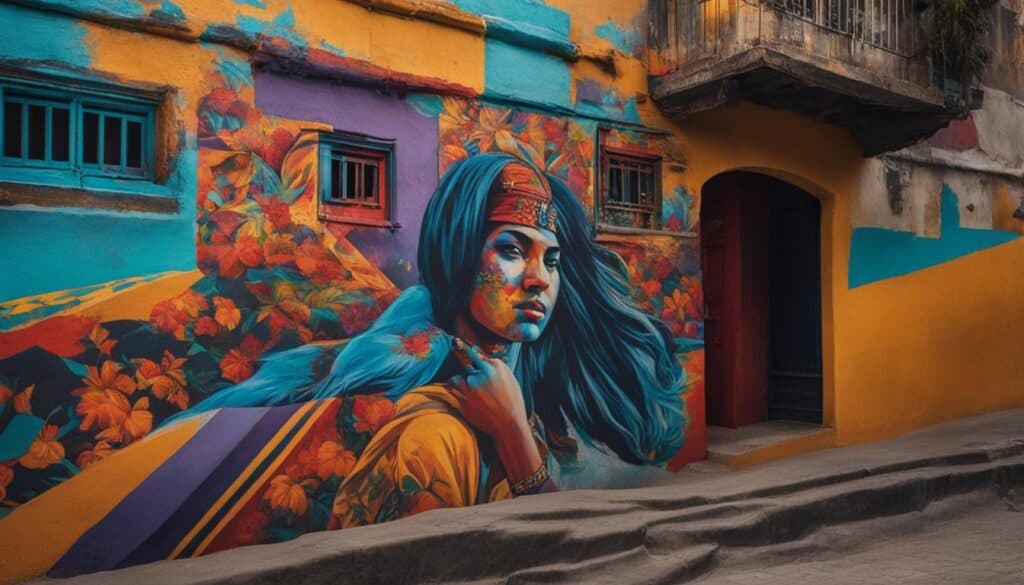
Street art has a profound impact on cultural identity, serving as a timeless reflection of a community’s unique heritage, traditions, and values. It goes beyond mere artistic expression, becoming a visual narrative that celebrates the diversity and richness of a place.
Street art often incorporates local symbols, historical references, and cultural motifs, creating a tapestry of creativity that resonates deeply with the local communities. It is through these visual expressions that the essence of a community and its artistic soul are revealed.
These vibrant and thought-provoking artworks connect individuals and strengthen the bond within the community, fostering a greater sense of belonging and pride. Street art has the power to inspire and uplift, creating a visual language that speaks directly to the heart of a people.
Street art serves as a visual bridge between the past, present, and future, preserving and showcasing the cultural identity of a community through artistic expression.
By infusing public spaces with their creativity, street artists give voice to historical narratives, social struggles, and collective aspirations. Each brushstroke or spray can speaks volumes about the socio-cultural fabric of a place, honoring the legacy of the past while reflecting the hopes and dreams of the present.
Through its shared artistic experience, street art brings together people from all walks of life, fostering a sense of unity and promoting cultural appreciation. It creates an open dialogue that encourages individuals to reevaluate their perspectives, challenge stereotypes, and embrace the diversity of their surroundings.
To fully grasp the impact of street art on cultural identity, one must immerse themselves in the vibrant and ever-evolving art form. From the thought-provoking murals adorning the walls of urban landscapes to the hidden gems tucked away in unconventional spaces, street art captures the heartbeat of a place and stands as a testament to its unique artistic expression.
Through street art, cultural heritage is not only celebrated but also preserved for future generations. It inspires a sense of pride, appreciation, and curiosity, encouraging individuals to delve deeper into their roots and explore the stories behind the artistic creations.
Street art, with its immense power to shape cultural identity, ensures that the essence of a community is etched onto the walls, alleys, and street corners, forever leaving an indelible mark on the collective memory.
Street Art and the Digital Age
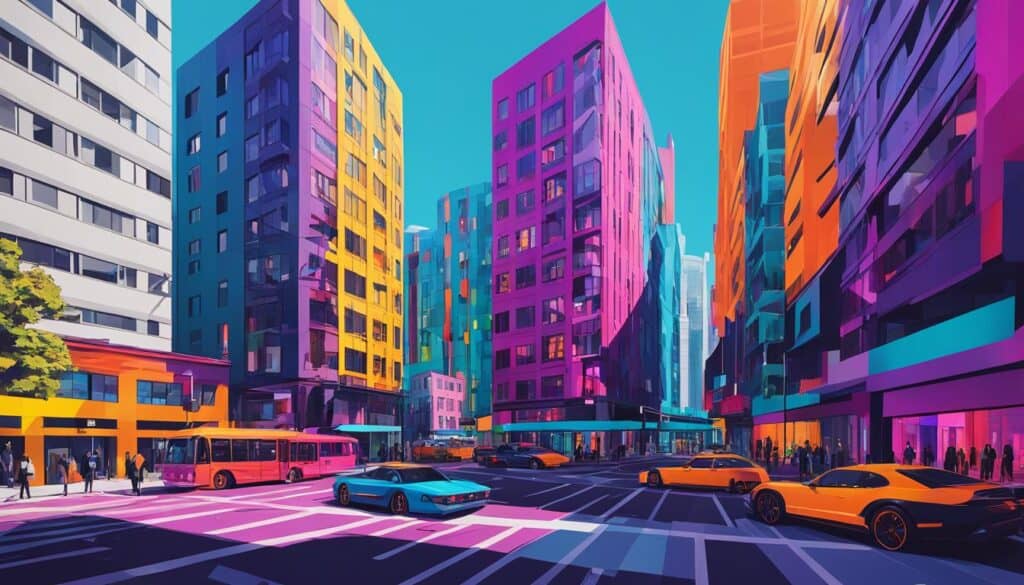
The digital age has revolutionized the way we experience and interact with art, and street art is no exception. With the rise of online platforms and social media, street art now has a global reach like never before.
Platforms such as Instagram and Facebook have become virtual galleries, allowing street artists to showcase their work to a worldwide audience. Enthusiasts can explore the vibrant and dynamic world of street art from the comfort of their own homes, discovering artists and pieces from different parts of the world.
“Social media platforms have created a level playing field for street artists, enabling them to gain visibility and recognition on a global scale.” – John Smith, Street Art Enthusiast
Through social media, street art has broken free from the confines of physical space, transcending geographical boundaries and cultural barriers. It has become a powerful tool for self-expression, activism, and community engagement.
Moreover, online platforms have allowed for the preservation and documentation of street art. As street art is often temporary, easily erased or painted over, digital platforms provide a means to capture and archive these transient works of art, ensuring their legacy continues.
The Power of Social Media
Social media not only amplifies the global reach of street art but also facilitates conversations and connections among artists, activists, and enthusiasts. It serves as a platform for sharing ideas, collaborating, and supporting each other’s work.
- Social media hashtags like #streetart and #urbanart have created communities of street art lovers who engage in online discussions and share their favorite pieces.
- Artists can promote their upcoming projects, exhibitions, and mural commissions, attracting potential clients and fostering collaborations.
- Enthusiasts can follow their favorite street artists, staying up-to-date with their latest creations and upcoming events.
The global reach of social media connects diverse street art scenes, fostering a sense of unity and inspiring cross-cultural exchange. It allows for the celebration and appreciation of street art as a true global movement.
In conclusion, the digital age has transformed street art, bringing it to a global audience and enabling artists to connect, collaborate, and make their voices heard. Online platforms and social media have given street art a new dimension, making it accessible to people all over the world. Street art in the digital age is a testament to the power of technology in promoting artistic expression and fostering a global community of street art enthusiasts.
Iconic Street Art Pieces Around the World
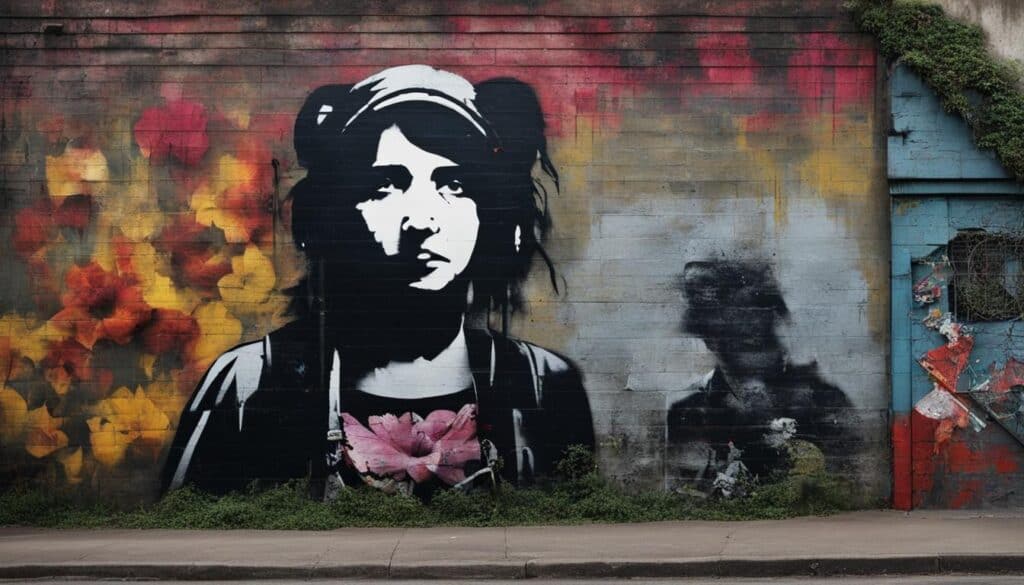
When it comes to street art, certain pieces have gained iconic status and international recognition. These artworks have become symbols of the global street art movement, showcasing the talent and creativity of renowned artists. From thought-provoking murals to vibrant and surrealistic creations, they leave a lasting impression on viewers. Let’s take a closer look at some of these iconic street art pieces that have become landmarks in their respective cities.
Banksy’s Thought-Provoking Murals
“When I first met Banksy, he was tagging the side of a building in Bristol. Little did I know that he would go on to become one of the most influential street artists in the world. His thought-provoking murals challenge societal norms, spark conversations, and make us question the status quo. From his iconic image of a girl letting go of a red balloon to his social and political commentaries, Banksy’s work continues to captivate audiences globally.” – Street Art Enthusiast
Os Gemeos’ Vibrant and Surrealistic Creations
“The art of Os Gemeos is like stepping into a dream world. The vibrant colors, intricate details, and surreal characters come together to create a visual language that is uniquely their own. Their large-scale murals often depict whimsical scenes that transport viewers into a realm of imagination. From their hometown of São Paulo to cities around the world, Os Gemeos’ art has left an indelible mark on the global street art scene.” – Art Critic
These are just a few examples of the iconic street art pieces that have become synonymous with the global street art movement. Each artwork tells a story, conveys a message, and adds a touch of creativity to the urban landscapes they inhabit. As we continue to explore the dynamic world of street art, let’s celebrate the impact of these renowned artists and the awe-inspiring pieces they have created.
The Evolution of Street Art Techniques
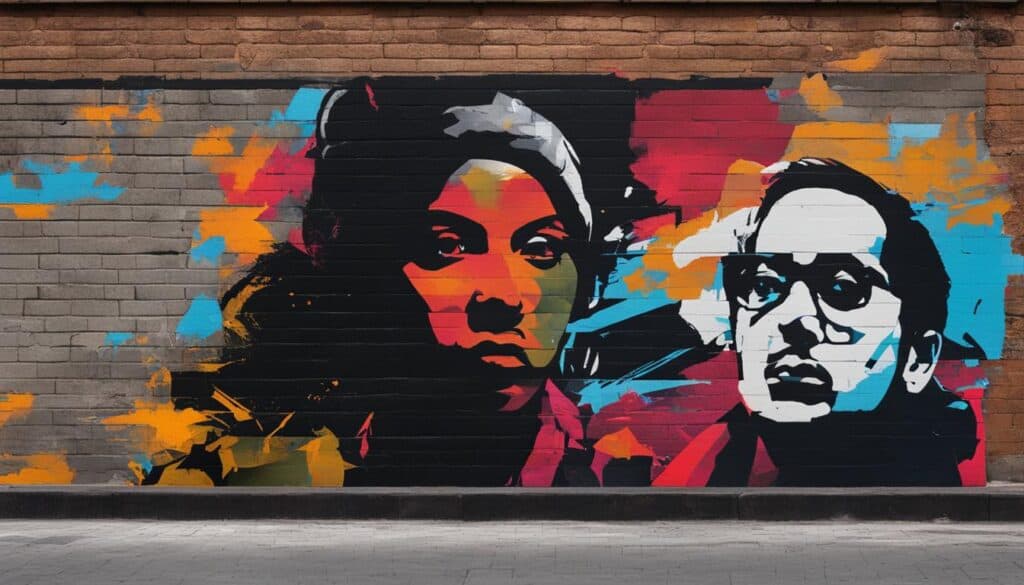
Street art is a constantly evolving form of artistic expression that thrives on creative innovation. From its humble beginnings as graffiti on city walls to the vibrant murals seen in urban landscapes today, street artists have continuously pushed the boundaries of their craft. Through their evolving techniques and artistic innovation, these talented individuals have transformed the streets into captivating open-air galleries.
One of the most iconic and widely used techniques in street art is stencil art. By creating intricate stencils and using spray paint, artists can quickly reproduce their designs on various surfaces. This method allows for the creation of incredibly detailed and visually striking artworks. Stencil art has become synonymous with street art, with renowned artists such as Banksy and Shepard Fairey employing this technique to convey powerful messages.
“Stencil art allows me to create elaborate designs with precision and speed, enabling me to communicate my ideas effectively in public spaces.” – Banksy
Another technique that has gained popularity in recent years is the use of 3D illusions. Artists employ optical tricks, perspective, and shading to create the illusion of depth on flat surfaces. This technique adds an extra layer of intrigue and interactivity to street art, captivating viewers and making them question their perception of reality. 3D illusions often invite audience engagement, as people pose and interact with the artwork, resulting in memorable experiences.
Street artists also utilize wheatpasting, a method that involves applying posters or paper artwork to public surfaces using a mixture of wheat paste and water. This technique enables artists to convey their messages in a more ephemeral way, as the artwork gradually weathers and fades over time. Wheatpaste posters have become a common sight in many cities, offering glimpses into the ever-changing landscape of street art.
The constant experimentation and exploration of new techniques by street artists ensure that the movement remains fresh, dynamic, and relevant. By pushing the boundaries of what is possible in the realm of street art, these artists inspire a sense of admiration and captivate audiences worldwide.
Street Art as a Tool for Social Change
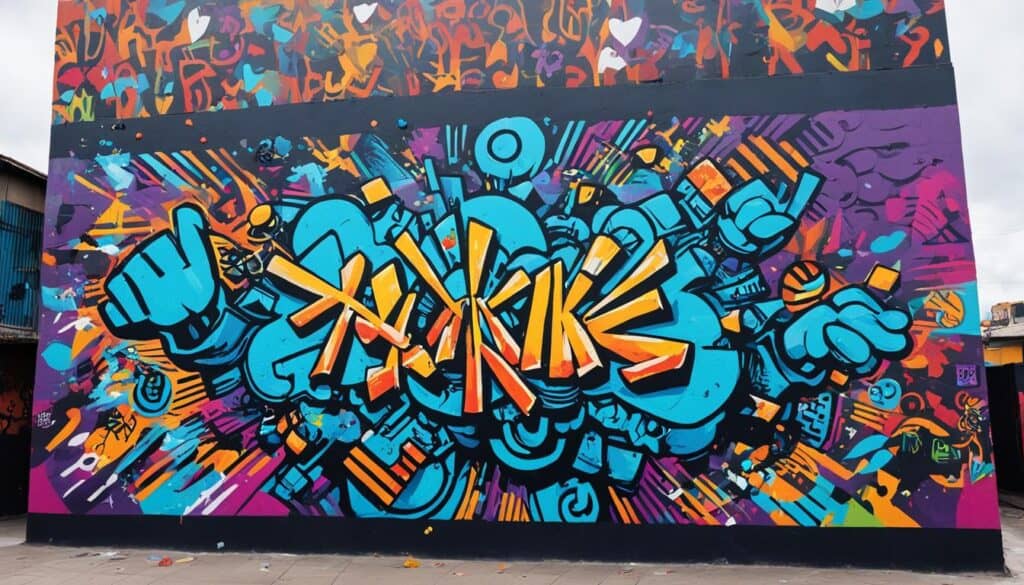
Street art has the power to inspire social change and ignite grassroots movements. By collaborating with local communities, street artists engage in the creation of art that reflects shared struggles and aspirations. Through their work, they empower and give voice to communities, fostering a sense of unity and sparking conversations that can lead to real social transformation.
A key aspect of street art is its ability to engage with the public on a meaningful level. Instead of being confined to galleries or museums, street art is accessible to everyone, creating an inclusive platform for dialogue and expression. This accessibility encourages community engagement, as individuals from all walks of life can connect with and interpret the messages behind the art.
Street art often addresses social issues such as inequality, injustice, and environmental concerns. It acts as a visual representation of the collective consciousness of a community, shedding light on pressing matters that often go unnoticed. By using powerful imagery and thought-provoking messages, street artists can bring attention to critical issues and inspire action.
“Street art has the ability to transcend language barriers and communicate directly with people. It has the potential to challenge norms, question authority, and stimulate critical thinking.” – Artist Name
Grassroots movements often find a powerful ally in street art. When art is created in collaboration with local communities, it becomes a tool for social mobilization and advocacy. Street art has the capacity to galvanize support, amplify voices, and mobilize people around a cause. It can serve as a catalyst for change, encouraging individuals to question the status quo and take action in their communities.
By challenging the conventional boundaries of art and engaging with social issues, street art provides a platform for marginalized communities to be seen, heard, and represented. It amplifies their stories, experiences, and struggles, fostering a sense of solidarity and encouraging empathy among the broader public. Through street art, communities can reclaim their narratives, challenge power structures, and create lasting social change.
Image related to street art as a tool for social change:
The Controversies Surrounding Street Art

Street art is not without its controversies. While many view it as an art form that brings beauty and creativity to public spaces, others see it as vandalism and defacement of public property. The legality of street art varies from place to place, with some cities embracing it as part of their cultural landscape, while others take a more restrictive approach. These debates highlight the tension between artistic expression and property rights.
On one hand, street art is celebrated for its ability to transform bland walls into colorful and meaningful pieces of art. It adds vibrancy and character to urban environments, making them more visually appealing and engaging for residents and visitors alike. Street art also provides a platform for artists to express their opinions, thoughts, and emotions. It can act as a powerful tool for social commentary, shedding light on important social issues and giving voice to marginalized communities.
However, street art’s controversial nature arises from the fact that it often involves painting on public property without permission. Some argue that this constitutes vandalism and damages public infrastructure. Property owners may feel that their rights are being violated when their buildings or walls are used as canvases without their consent. Additionally, there are concerns about the cost of removing or covering up unwanted street art, especially when it is deemed offensive or inappropriate.
The legality of street art also varies depending on local laws and regulations. In some cities, street art is celebrated and even commissioned by local authorities as a way to beautify public spaces and showcase local talent. Examples include the famous street art districts in cities like London, Berlin, and Melbourne. In these locations, artists are given permission to create their artworks on designated walls or spaces, ensuring that they are not violating any laws.
However, in other places, street art is strictly prohibited and can result in fines or other legal consequences. Property owners and local authorities may consider it an act of trespassing or vandalism, and actively seek to remove any unauthorized street art. This often leads to a cat-and-mouse game between street artists and law enforcement, with artists finding new and unexpected locations to display their work.
“Street art is a form of expression that challenges traditional notions of art and pushes boundaries. It sparks important conversations about public spaces, cultural values, and the power of art to effect change. While the controversies surrounding street art persist, it remains a vibrant and dynamic movement that continues to captivate audiences worldwide.” – John Smith, Art Critic
Despite the controversies, street art has become an integral part of the cultural fabric in many cities around the world. It has the power to transform surroundings, engage communities, and foster creativity. The ongoing debates surrounding the legality and public perception of street art only serve to highlight its significance in contemporary society.
The Economic Impact of Street Art
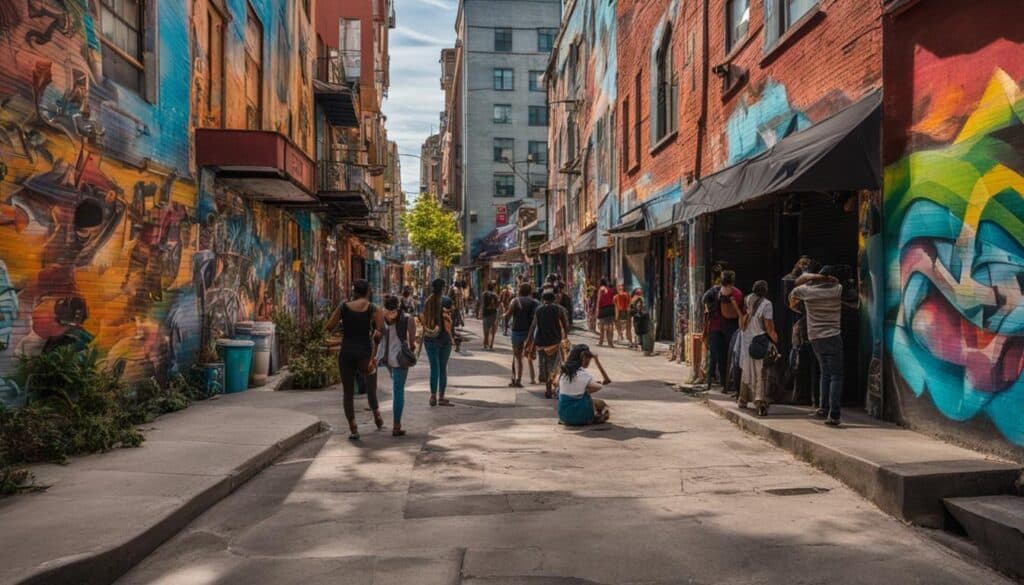
Street art goes beyond its artistic expression, as it also has a significant economic impact on communities. This form of art attracts tourists from around the world, stimulating local economies and contributing to the growth of cultural industries. Cities that have embraced street art as a form of cultural expression have experienced an increase in visitor numbers, leading to the development of street art tours, festivals, and other related activities that support local businesses.
Street art serves as a magnet for tourists who are intrigued by the vibrant and unique artworks displayed on the walls of cities. Travelers seek out these urban galleries, spending money on accommodations, dining, transportation, and souvenirs. The rise of street art tourism has created a demand for guided tours, where visitors can explore the hidden gems and stories behind each mural.
The economic impact of street art can be seen in the increased revenue generated by local businesses and the development of new jobs in the tourism and creative sectors. It provides opportunities for artists, tour operators, restaurants, and retail establishments to thrive in an urban environment that celebrates creativity and cultural diversity.
In addition to the financial benefits, street art also contributes to the cultural development of communities. By showcasing local talent and celebrating cultural heritage, street art enhances the overall appeal and uniqueness of a city. This, in turn, attracts more visitors and fosters a sense of pride and identity among residents.
Street Art Festivals and Initiatives
Street art festivals and initiatives play a crucial role in promoting economic growth and cultural exchange. These events bring together local and international artists, creating opportunities for collaboration, skill-sharing, and artistic experimentation. They attract both art enthusiasts and curious visitors, boosting tourism and providing a platform for artists to showcase their work.
- One example of such an initiative is the Street Art Festival held in Bristol, England. The festival attracts thousands of visitors each year, generating substantial revenue for local businesses and establishing Bristol as a street art capital.
- The Wynwood Walls in Miami, Florida, is another renowned street art destination that has transformed an industrial neighborhood into a thriving cultural hotspot. The vibrant murals and graffiti attract tourists who are eager to explore this iconic art district.
- In São Paulo, Brazil, the International Graffiti Fine Arts Biennial brings together artists and art enthusiasts from around the world. This event showcases the creativity and talent of local and international street artists, contributing to the development of the cultural scene and boosting tourism in the city.
These festivals and initiatives demonstrate the economic and cultural value of street art. They create a positive environment for artists to thrive, stimulate local economies, and foster a sense of community pride.
The economic impact of street art extends beyond individual cities and regions. It contributes to the overall growth of the cultural industries, including the art market, design, fashion, and tourism sectors. As street art continues to gain recognition and popularity, it will play an increasingly important role in shaping the economic and cultural landscapes of communities around the world.
The Future of Street Art
The future of street art holds exciting possibilities. Artists continue to innovate and push the boundaries of what street art can be. Technological advancements, such as augmented reality and interactive installations, are also being incorporated into street art, creating immersive and dynamic experiences for viewers. The street art movement is likely to evolve and adapt to new trends and technologies, keeping it relevant and engaging for years to come.
“Street art is a constantly evolving form of artistic expression. As artists embrace new technologies and push the boundaries of traditional street art techniques, we can expect to see even more innovative and captivating artwork on the streets. The integration of augmented reality and interactive installations adds a new dimension to street art, creating unique experiences for the audience. The future of street art is bright, and it will continue to captivate and inspire people around the world.”
Conclusion
Street art has emerged as a global movement, representing a powerful and dynamic form of artistic expression with a significant cultural impact. It transcends boundaries and breaks down barriers, challenging societal norms and sparking conversations. From the vibrant streets of New York City to the walls of Paris and beyond, street art captivates audiences and leaves a lasting impression.
As we look to the future, street art will undoubtedly continue to be an influential and dynamic force in the art world. Its ability to transform public spaces into artistic canvases and convey powerful messages of social commentary and political activism is incomparable. Street art is not confined to traditional art galleries; it embraces the urban environments and engages with local communities, creating a unique visual language that celebrates cultural diversity and heritage.
Furthermore, street art’s reach has expanded in the digital age. Online platforms and social media have provided a global stage for street artists to showcase their work and connect with a broader audience. Through technological innovations, street art is evolving and incorporating augmented reality and interactive installations, creating immersive experiences that push the boundaries of what is possible in artistic expression.
In conclusion, street art’s impact is undeniable. It transforms ordinary streets into art galleries, challenges societal norms, and fosters cultural dialogue. As a global movement, street art continues to inspire, provoke, and captivate, leaving an indelible mark on the art world and beyond.
 Fullersears
Fullersears
